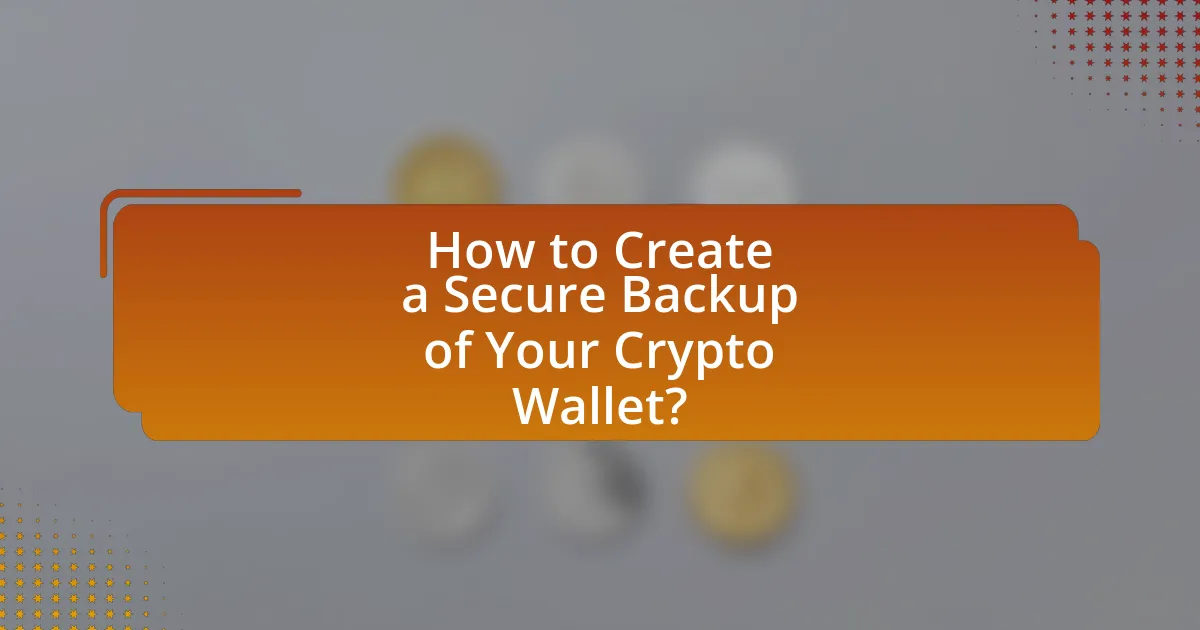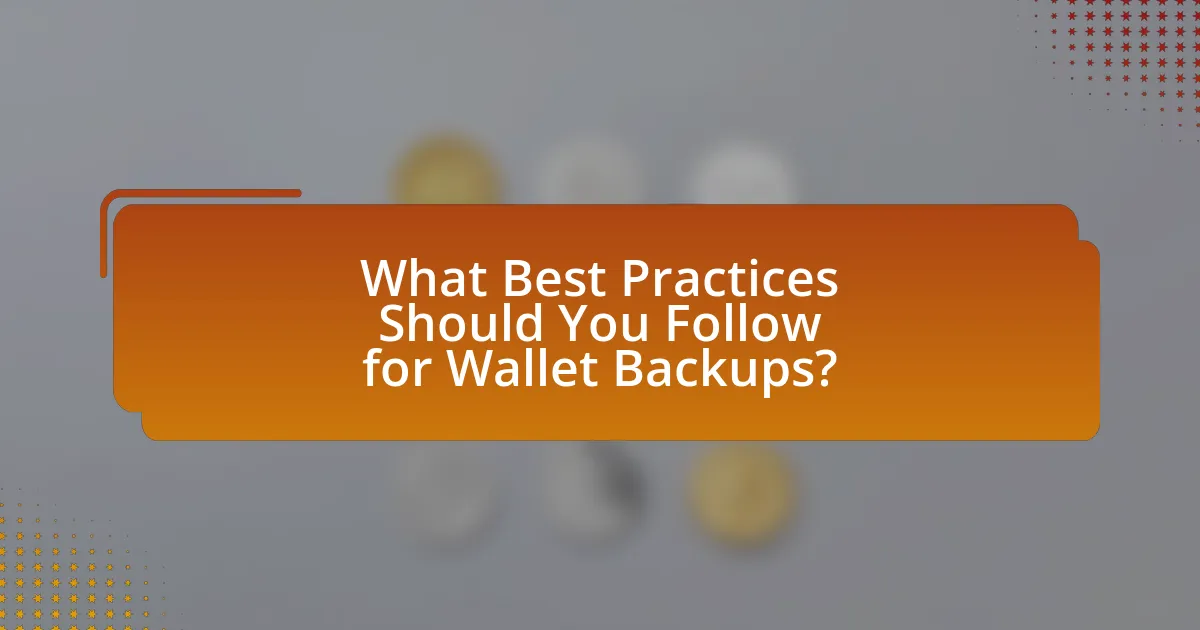A crypto wallet backup is a crucial security measure that allows users to restore access to their cryptocurrency holdings in the event of loss or damage to the original wallet. This article outlines the importance of backing up crypto wallets, the risks associated with neglecting this practice, and the various methods available for creating secure backups. It also differentiates between hot and cold wallets, discusses best practices for maintaining backups, and highlights common mistakes to avoid. By following the guidelines provided, users can effectively safeguard their digital assets against potential threats and ensure their accessibility.

What is a Crypto Wallet Backup?
A crypto wallet backup is a secure copy of the data that allows users to restore access to their cryptocurrency holdings in case of loss or damage to the original wallet. This backup typically includes the wallet’s private keys and recovery phrases, which are essential for accessing the funds stored in the wallet. According to industry standards, users are advised to create backups regularly and store them in multiple secure locations to mitigate the risk of loss due to hardware failure, theft, or accidental deletion.
Why is backing up your crypto wallet important?
Backing up your crypto wallet is important because it protects your digital assets from loss due to hardware failure, theft, or accidental deletion. A backup ensures that you can restore access to your cryptocurrencies even if your device is compromised or damaged. According to a study by the Cambridge Centre for Alternative Finance, approximately 20% of all Bitcoin is considered lost, often due to the lack of proper backups. This statistic highlights the critical need for users to create secure backups to safeguard their investments.
What risks are associated with not backing up your crypto wallet?
Not backing up your crypto wallet exposes you to significant risks, primarily the irreversible loss of your digital assets. If your device fails, is lost, or is compromised, you may permanently lose access to your cryptocurrencies, as they are stored on that wallet without any recovery options. According to a study by Chainalysis, approximately 20% of all Bitcoin is considered lost due to users failing to back up their wallets or losing access to their private keys. This statistic underscores the critical importance of maintaining secure backups to prevent financial loss.
How can a backup protect your assets?
A backup can protect your assets by ensuring that you have a secure copy of your data, which can be restored in case of loss, theft, or corruption. In the context of a crypto wallet, a backup allows you to recover your private keys and transaction history, safeguarding your cryptocurrency holdings against accidental deletion or hardware failure. According to a study by the Blockchain Research Institute, 20% of Bitcoin is estimated to be lost due to users failing to back up their wallets properly. This statistic underscores the critical importance of maintaining a reliable backup to prevent asset loss.
What types of crypto wallets require backups?
Hot wallets and hardware wallets require backups. Hot wallets, which are connected to the internet, are vulnerable to hacks and data loss, making backups essential for recovery. Hardware wallets, while more secure, also necessitate backups to restore access in case of device failure or loss. Both types typically use seed phrases or recovery keys for this purpose, ensuring users can regain access to their funds.
What are the differences between hot wallets and cold wallets?
Hot wallets are online cryptocurrency storage solutions that are connected to the internet, while cold wallets are offline storage methods that are not connected to the internet. Hot wallets, such as web wallets and mobile apps, provide convenience for frequent transactions but are more vulnerable to hacking and cyber attacks due to their online nature. In contrast, cold wallets, including hardware wallets and paper wallets, offer enhanced security by keeping private keys offline, making them less susceptible to online threats. The distinction between these two types of wallets is crucial for users to understand in order to effectively manage the security of their cryptocurrency assets.
How does the wallet type influence the backup process?
The wallet type significantly influences the backup process by determining the method and complexity of securing the wallet’s private keys and recovery phrases. Hardware wallets typically require users to back up their recovery seed phrases, which are generated during the initial setup, while software wallets may offer options for cloud backups or encrypted file storage. For instance, a hardware wallet’s backup process is often straightforward, involving writing down a seed phrase, whereas a mobile wallet might necessitate regular updates to backup files due to frequent transactions. This distinction is crucial because the backup method directly impacts the security and accessibility of the wallet’s contents, with hardware wallets generally providing a more secure backup option compared to software wallets that may be more vulnerable to online threats.

How to Create a Secure Backup of Your Crypto Wallet?
To create a secure backup of your crypto wallet, first, ensure you have the wallet’s recovery phrase or seed phrase written down and stored in a safe location, as this is essential for wallet recovery. Additionally, use hardware wallets or encrypted USB drives to store your wallet files, ensuring they are kept offline to prevent hacking attempts. It is also advisable to create multiple copies of your backup and store them in different secure locations, such as a safe deposit box or a fireproof safe, to mitigate the risk of loss or damage. Following these steps ensures that your crypto assets remain accessible and secure in case of device failure or loss.
What methods can be used to back up a crypto wallet?
To back up a crypto wallet, users can utilize methods such as creating a paper wallet, exporting private keys, and using hardware wallets. A paper wallet involves generating a physical printout of the wallet’s public and private keys, ensuring offline storage. Exporting private keys allows users to save their keys in a secure digital format, which can be stored on an encrypted USB drive. Hardware wallets provide a secure environment for storing private keys offline, minimizing exposure to online threats. These methods are widely recognized for their effectiveness in safeguarding cryptocurrency assets against loss or theft.
How does using a hardware wallet enhance backup security?
Using a hardware wallet enhances backup security by storing private keys offline, which significantly reduces the risk of unauthorized access. Unlike software wallets that are connected to the internet and vulnerable to hacking, hardware wallets keep sensitive information in a secure environment, making it nearly impossible for malware or online threats to compromise the keys. Additionally, hardware wallets often include features such as seed phrase generation and recovery options, allowing users to create secure backups that can be restored if the device is lost or damaged. This combination of offline storage and robust backup mechanisms ensures that users maintain control over their cryptocurrency assets while minimizing the potential for loss or theft.
What are the advantages of using paper backups?
Using paper backups offers several advantages for securing your crypto wallet. Firstly, paper backups are immune to digital threats such as hacking, malware, and ransomware, which can compromise electronic storage methods. This physical format ensures that your private keys or recovery phrases remain safe from online vulnerabilities. Additionally, paper backups are easily accessible without the need for electronic devices, making them reliable in situations where technology fails or is unavailable. Furthermore, they can be stored in secure locations, such as safes or safety deposit boxes, providing an extra layer of protection against theft or loss. The simplicity and durability of paper as a medium also contribute to its effectiveness, as it does not require power or software to access the information.
What steps should you follow to back up your wallet securely?
To back up your wallet securely, first, identify the type of wallet you are using, whether it’s a hardware, software, or paper wallet. Next, create a backup of your wallet’s private keys or recovery phrase by writing them down on paper and storing them in a safe location, such as a safe deposit box. Additionally, consider using encrypted digital storage for backups, ensuring that the storage method is secure and not easily accessible to unauthorized users. Regularly update your backup whenever you make significant changes to your wallet, such as adding new assets. Following these steps ensures that you can recover your wallet in case of loss or theft, as the private keys or recovery phrases are essential for accessing your funds.
How do you generate a recovery phrase?
To generate a recovery phrase, use a cryptocurrency wallet that provides this feature, which typically involves creating a series of random words. The wallet software generates a recovery phrase, often consisting of 12 to 24 words, based on a standard like BIP39, ensuring that the phrase is unique and secure. This phrase allows users to restore access to their wallet and funds in case of loss or device failure. The generation process is designed to be secure, utilizing cryptographic algorithms to ensure randomness and unpredictability, which is crucial for safeguarding digital assets.
What precautions should you take when storing your backup?
When storing your backup, ensure it is encrypted to protect against unauthorized access. Encryption secures the data, making it unreadable without the correct decryption key. Additionally, store backups in multiple physical locations to mitigate risks from theft, fire, or hardware failure. For instance, using both a secure cloud service and an external hard drive can provide redundancy. Regularly update your backups to include the latest wallet information, as outdated backups may lead to loss of access. Finally, use strong, unique passwords for any accounts associated with your backups to enhance security against hacking attempts.

What Best Practices Should You Follow for Wallet Backups?
To securely back up your crypto wallet, you should follow these best practices: create multiple copies of your backup, store them in different physical locations, and use strong encryption methods. Multiple copies ensure redundancy; if one is lost or damaged, others remain accessible. Storing backups in different locations protects against theft, fire, or other disasters. Strong encryption adds a layer of security, making it difficult for unauthorized users to access your wallet information. According to the Federal Trade Commission, securing your digital assets through these methods significantly reduces the risk of loss or theft.
How often should you update your wallet backup?
You should update your wallet backup every time you make a significant change, such as adding or removing assets. This ensures that your backup reflects the most current state of your wallet, minimizing the risk of losing access to your funds. Regular updates, ideally after each transaction or at least once a month, help maintain the integrity of your backup. According to best practices in cryptocurrency management, keeping your backup current is crucial for security and recovery purposes.
What factors determine the frequency of updates?
The frequency of updates for securely backing up a crypto wallet is determined by several key factors, including the rate of software development, security vulnerabilities, user activity, and changes in regulatory requirements. Software development teams often release updates to improve functionality and address bugs, which can necessitate more frequent updates. Security vulnerabilities, particularly in the rapidly evolving crypto landscape, require immediate attention, prompting updates to protect user assets. User activity, such as increased transactions or changes in wallet usage patterns, can also influence how often updates are needed to ensure optimal performance and security. Lastly, changes in regulatory requirements may lead to updates to comply with new laws or guidelines, ensuring that the wallet remains compliant and secure.
How can you ensure your backup remains secure over time?
To ensure your backup remains secure over time, implement strong encryption methods and regularly update your security protocols. Strong encryption protects your backup data from unauthorized access, while regular updates address potential vulnerabilities. For instance, using AES-256 encryption is a widely recognized standard that secures data effectively. Additionally, storing backups in multiple secure locations, such as hardware wallets or encrypted cloud services, further mitigates risks. Regularly reviewing and updating your security measures, including software updates and password changes, is essential to maintaining the integrity of your backup over time.
What common mistakes should you avoid when backing up your wallet?
When backing up your wallet, avoid common mistakes such as not using strong passwords, failing to store backups in multiple secure locations, and neglecting to regularly update your backup. Strong passwords protect against unauthorized access, while storing backups in different secure locations mitigates the risk of loss due to theft or damage. Regularly updating your backup ensures that you have the most recent data, which is crucial for recovery. According to a study by the Blockchain Research Institute, 30% of users lose access to their wallets due to inadequate backup practices, highlighting the importance of these precautions.
How can poor storage choices compromise your backup?
Poor storage choices can compromise your backup by increasing the risk of data loss, unauthorized access, and corruption. For instance, using unreliable storage media, such as outdated hard drives or unencrypted cloud services, can lead to failures or breaches. According to a study by Backblaze, hard drives have varying failure rates, with some models failing as much as 20% within five years, highlighting the importance of selecting reliable storage options. Additionally, storing backups in easily accessible locations without encryption exposes sensitive information to potential theft. Therefore, making informed storage choices is crucial for maintaining the integrity and security of your crypto wallet backups.
What are the risks of sharing your backup information?
Sharing your backup information poses significant risks, primarily including unauthorized access to your cryptocurrency assets. When backup information is disclosed, malicious actors can exploit this data to gain control over wallets, leading to potential theft of funds. A study by the Cybersecurity & Infrastructure Security Agency (CISA) highlights that 90% of cyberattacks involve some form of credential theft, underscoring the vulnerability associated with sharing sensitive information. Additionally, sharing backup information can compromise the integrity of your security measures, as it increases the likelihood of phishing attacks and social engineering tactics aimed at deceiving individuals into revealing further sensitive data.
What are some practical tips for securely backing up your crypto wallet?
To securely back up your crypto wallet, utilize hardware wallets, which store private keys offline, minimizing exposure to online threats. Additionally, create multiple copies of your wallet’s recovery phrase and store them in secure, geographically diverse locations to prevent loss from theft or natural disasters. Use strong passwords and enable two-factor authentication on any online wallet services to add an extra layer of security. Regularly update your backup methods to adapt to evolving security threats and ensure compatibility with your wallet software. These practices are essential for safeguarding your digital assets against potential risks.


